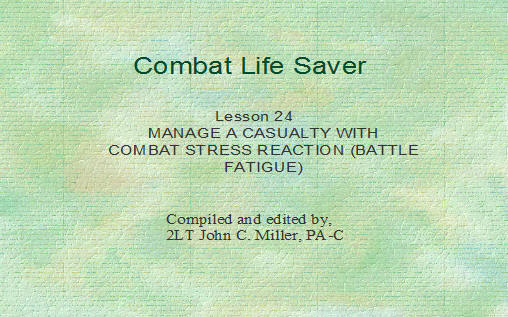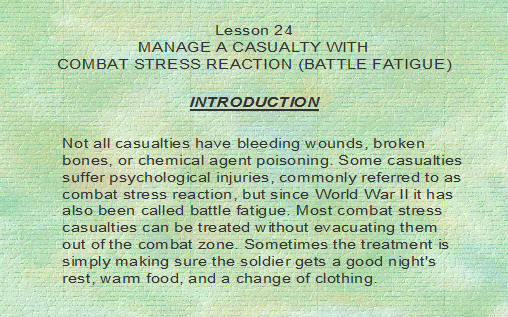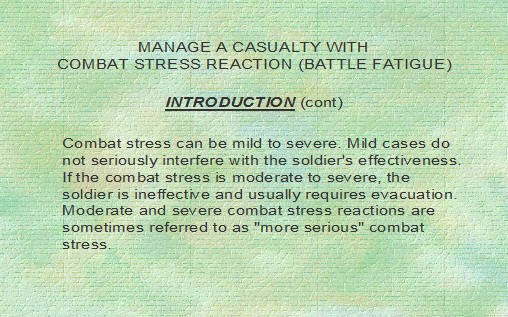MANAGE A CASUALTY WITH COMBAT STRESS REACTION (BATTLE FATIGUE)
Click here to download the presentation.



Lesson 24
MANAGE A CASUALTY WITH
COMBAT STRESS REACTION (BATTLE FATIGUE)
INTRODUCTION
Not all casualties have bleeding wounds, broken bones, or chemical agent poisoning. Some casualties suffer psychological injuries, commonly referred to as combat stress reaction, but since World War II it has also been called battle fatigue. Most combat stress casualties can be treated without evacuating them out of the combat zone. Sometimes the treatment is simply making sure the soldier gets a good night’s rest, warm food, and a change of clothing.
MANAGE A CASUALTY WITH
COMBAT STRESS REACTION (BATTLE FATIGUE)
INTRODUCTION (cont)
Combat stress can be mild to severe. Mild cases do not seriously interfere with the soldier’s effectiveness. If the combat stress is moderate to severe, the soldier is ineffective and usually requires evacuation. Moderate and severe combat stress reactions are sometimes referred to as “more serious” combat stress.
MANAGE A CASUALTY WITH
COMBAT STRESS REACTION (BATTLE FATIGUE)
TASK
Identify characteristics of combat stress reaction and its treatment.
CONDITIONS
Given written items pertaining to the identification and treatment of combat stress reaction.
STANDARD
Score 70 or more points on the 100-point written examination.
IDENTIFY THE CAUSES OF COMBAT STRESS
Some of the problems which contribute to the development of combat stress are:
Physical exhaustion.
Constant alertness.
Loss of sleep.
Trauma of seeing fellow soldiers wounded or killed.
Fear of being killed or maimed.
Fear of killing other people.
Fear of failure or disgrace.
Worry about family problems back home.
IDENTIFY THE SIGNS AND SYMPTOMS OF
MILD COMBAT STRESS REACTION
Physical Signs and Symptoms
Tenseness, jumpy, startled at sudden sounds or movement.
Headache, backache, pain in old wounds.
Fidgeting, fine trembling of the hands, fumbling.
Cold sweat, dry mouth, pale skin.
Blurred vision.
IDENTIFY THE SIGNS AND SYMPTOMS OF
MILD COMBAT STRESS REACTION
Pounding heart, feeling dizzy or light-headed.
Feeling “out of breath,” breathing too rapidly.
Tingling, cramps, or numbness in fingers and toes.
Upset stomach, “dry heaves,” or actual vomiting.
Uncontrollable emptying of bowels and bladder when danger suddenly appears.
Fatigue, feeling drained of energy.
Blank, haunted, “1000-yard” stare.
IDENTIFY THE SIGNS AND SYMPTOMS OF
MILD COMBAT STRESS REACTION
Mental and Emotional Signs and Symptoms
Anxiety, worrying, bothered by little things.
Irritability, complaining.
Difficulty in paying attention or remembering details.
Difficulty in thinking, speaking, and communicating.
Sleeping difficulties, such as being awakened by bad dreams.
Grieving, tearfulness, crying for a dead or wounded buddy.
IDENTIFY THE SIGNS AND SYMPTOMS OF
MILD COMBAT STRESS REACTION
Feeling guilty about mistakes made or at things that had to be done.
Anger, resentment.
Feeling let down others, loss of confidence in self and/or others.
TREAT A CASUALTY WITH
MILD COMBAT STRESS REACTION
Be calm.
Keep the soldier focused on the unit’s immediate mission.
Encourage the soldier to eat, bathe, and sleep as the tactical mission and safety permit.
Keep the soldier busy when he is not resting.
Get the soldier to perform simple, well-learned tasks.
Have the soldier use relaxation techniques (take a deep breath and let it out slowly, etc.).
TREAT A CASUALTY WITH
MILD COMBAT STRESS REACTION
Allow and encourage the soldier to ventilate his feelings.
Remind the soldier that some degree of combat stress reaction is normal and to be expected.
IDENTIFY THE SIGNS AND SYMPTOMS OF
MODERATE/SEVERE COMBAT STRESS REACTION
Physical Signs and Symptoms
Cannot keep still, constantly moving around.
Arms or whole body shake.
Cowering in terror.
Flinching or ducking at almost any sudden sound or movement.
Sudden paralysis (hand, arm, leg) with no injury.
Sudden blindness or deafness (partial or complete) with no injury.
IDENTIFY THE SIGNS AND SYMPTOMS OF
MODERATE/SEVERE COMBAT STRESS REACTION
Total immobility (freezing) under fire.
Total physical exhaustion (just stands or sits).
Staggering or swaying when standing.
IDENTIFY THE SIGNS AND SYMPTOMS OF
MODERATE/SEVERE COMBAT STRESS REACTION
Mental and Emotional Signs and Symptoms
Rapid talking, constantly making suggestions.
Starting fights, recklessness, “vicious” behavior within own group, uncontrollable anger.
Social withdrawal (silence, sulking, prolonged sadness).
Inattentiveness to self-care and hygiene, no interest in eating.
Apathetic and indifferent to danger.
IDENTIFY THE SIGNS AND SYMPTOMS OF
MODERATE/SEVERE COMBAT STRESS REACTION
Cannot remember orders, how to perform duties, or where he is.
Inability to concentrate or make decisions.
Severe speech problems, including stuttering and inability to talk.
Fear of sleeping, even in a relatively safe area.
Sees things which are not there (usually after severe sleep loss).
Rapid emotional swings, hysteria, strange behavior.
Panic running under fire.
TREAT A CASUALTY WITH
MODERATE/SEVERE COMBAT STRESS REACTION
A soldier suffering from moderate or severe combat stress reaction usually requires routine evacuation. Combat stress reaction patients should be managed separately from other patients. Combat stress reaction casualties usually recover completely after resting in a safe area, being able to clean up, and receiving hot, nutritious meals. About 70 to 85 percent of evacuated combat stress reaction casualties are capable (with good management) of returning to their combat units within three days.
TREAT A CASUALTY WITH
MODERATE/SEVERE COMBAT STRESS REACTION
Early on, these patients need to talk, ventilate to any medical person. All combat stress reaction patients should be treated with the expectation of their going back to duty. Most of the remainder will return to their own unit or to another unit within two weeks.
Appear to be calm and in control of the situation.
Calmly try to talk the casualty into cooperating if he is responsive.
TREAT A CASUALTY WITH
MODERATE/SEVERE COMBAT STRESS REACTION
If the soldier appears to be dangerous, take his weapon away from him.
Physically restrain the casualty if the soldier is a
danger to himself or others.
Get medical assistance if possible.
Evacuate the casualty if he does not improve or if he is dangerous. Restrain the casualty if needed.
TREAT A CASUALTY WITH
MODERATE/SEVERE COMBAT STRESS REACTION
Question:
What are some of the things done to help mild and more serious combat stress casualties recover?
Response:
Normal activities such as sleeping, eating, and getting cleaned up which the soldier has been denied due to combat conditions.
Question:
About how many combat stress casualties that are evacuated return to the unit within three days?
Response:
70 to 85 percent.
MANAGE A CASUALTY WITH
COMBAT STRESS REACTION (BATTLE FATIGUE)
CLOSING
Procedures used to treat mild combat stress reaction casualties can also be used to prevent combat stress from developing. When a combat stress reaction casualty returns to the unit, welcome him back. Be willing to talk about what happened and express your confidence in him. Make him feel part of the unit again. Remember, no one is immune to combat stress reaction.
This lesson is tested in the written multiple-choice examination.
Questions